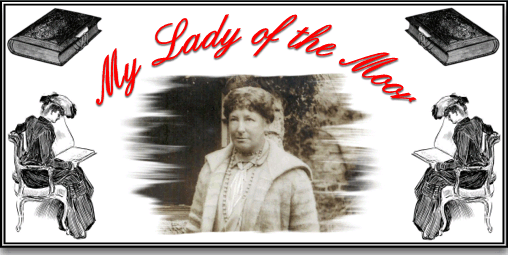
When looking at the literature of Dartmoor there probably was no greater character as the author Olive Parr who wrote under the pen name of Beatrice Chase. Possibly the word ‘character’ is a bit kind, eccentric would be polite and egotist nearer the truth. There is no doubt that the self-appointed ‘My Lady of the Moor’ was a true Dartmoor lover and that she campaigned vigorously for the preservation of its natural environment and people. How did she obtain such a prodigious title? Simple, a fellow writer, John Oxenham wrote a novel in which Beatrice Chase was the heroine, the book was called, ‘My Lady of the Moor’ and she simply adopted the title. There is a tradition that when the title was bestowed on her she proudly stated that she was, “not the Queen of the Moor”, but then added, “Royalties never use surnames so why should I”.
The Woman.
Olive Katherine Parr was born at Harrow in Middlesex in 1874, she was educated at the convent of the Holy Child in Cavendish Square. Later both her and her mother worked to improve life in the slums and workhouses of London and it was here at the age of 28 she contracted T.B. As a result of this disease her doctor advised a move into the countryside and in the early 1900’s she and her mother moved to Venton which is near Widecombe in the Moor. It was here that she began writing books which basically were of a romantic type, full of praise for both God and Dartmoor.
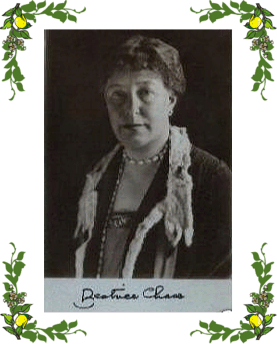
Beatrice Chase always claimed that she was a direct descendant from William Parr, the brother of Henry VIII’s last wife, Katherine Parr. To this end she always used a signet depicting the Rose of Lancaster to seal her letters and private papers.
Throughout her life, Beatrice Chase had always strong religious beliefs which became much deeper after her fiancé was killed in action during the First World War. She went as far as taking her novitiate vows for the Dominican Order but the had second thoughts. It was after this that she embarked on a personal crusade for Chastity. She also was very active in campaigning for the war effort and her small personal chapel at Venton became something of a shrine to the valiant soldiers. She initiated what she called her, ‘Knights of the White Crusade’ and those soldiers always knew that in the small chapel she prayed for their safety. The aim of the White Knights was to encourage all servicemen to be ‘pure and noble’ and its success was dubious to say the least.
As with everything in her life the people and pets all had nicknames, her mother was the ‘Rainbow Maker’ because of the glassy necklaces she wore. Incidentally, Mrs Parr later sold all her jewellery to raise funds for ‘poor gentlewomen working in large cities’. The money bought a nearby cottage which was called ‘St. Michael’s Little Home of Rest’ and it was here the gentlewomen from the cities would come to stay in order to recuperate from city life on Dartmoor. Eventually two other buildings were used and these became known as ‘The Anchorage’ and St. Gabriel’s. Locally Mrs Parr also got involved in good works amongst which was the establishment of a clothing club and a Sunday school. She also turned over one of the rooms from the rest home to a working mans reading room. In similar vane, her man servant was always called ‘Bluejacket’ and her dog became the ‘Tweed Dog’, apparently its coat resembled Beatrice’s tweed skirts. She also employed a young girl as her secretary, who was Lily Kernick who soon became known as Liliputia.
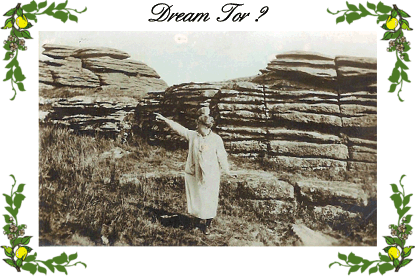
It did not take long for Beatrice Chase to become a popular writer with readers from far and wide. Her many books lovingly portrayed the moor and the many people who lived upon it, it was as if she was bringing the very essence of Dartmoor to her readers. Having wrote so passionately about Dartmoor it is not surprising that she became involved in its preservation, in particular she campaigned strongly against the military’s use of the moor. Beatrice was also very anti the formation of the Dartmoor National Park and campaigned against it, sadly all to no avail as we well know today. Upon the formation of the national park she wrote:
“The whole of England and the big open spaces, the watersheds and visibility from the sea for signalling are being siezed …for our enemies.”
She also took an interest in the Dartmoor Prison and visited there on occasions. It seems that at some stage she took interest in one particular prisoner and somehow secured his release. Sadly he died shortly afterwards and Beatrice had him interred in the small chapel with a memorial stone in the floor. Amongst her many interests were a passion for gardening and she was also a member of the Royal Meteorological Society for whom she kept records of the Dartmoor weather. In the 1930’s Beatrice took up photography and this combined with her love for walking the more led to the postcard maker, Ralph Tuck signed her up to produce pictures for his postcards.
Having had a previous dispute with booksellers who she accused of, “infamous profiteering”, she then took to selling her books and postcards to her many visitors to Venton. In 1938 she was reported as saying that trade was, “humming”, and that the house was open until eight o’clock in the evening. This period also saw her turn into a bitter and spiteful woman seeking only solitude. Her popularity had waned and as a recluse she couldn’t sell any of her books or cards this resulted in several desperate measures including selling her jewellery and her own personal library and picture collection. Illness soon struck and eventually she was taken to Newton Abbot Infirmary where she died on the 3rd of July 1955. She had expressed a wish to be buried in a field near Venton and that she should be dressed in a Dominican habit and placed in a coffin with no lid. Her grave sits in Widecombe churchyard, opposite her mother’s grave and the only wish complied with was that she was buried in a Dominican habit. Her tombstone is a simple granite cross upon which one side reads, “Pray for Olive Katherine Parr”, and on the other, “Beatrice Chase – 1874 – 1955”.
During her lifetime she had been described as outspoken, warm-hearted, selfish, impulsive, generous, having a sense of humour, bitter, and spiteful. Her story seems to be a typical case of ‘riches to rags’ but having said that her works are still to be found on second-hand bookshops and some of them fetch a high price. Or could yet again this be another example of Old Crockern’s curse – “scratch my back and I’ll rip out your pockets”.
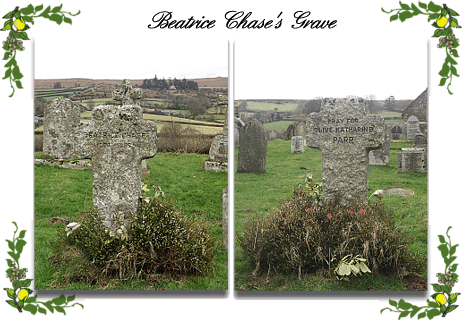
Venton.
As mention above, it was in the early 1900’s that Beatrice Chase moved to Venton which was a small hamlet just outside Widecombe-in-the-Moor.
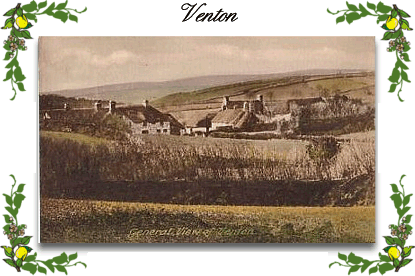
As was her wont, many of the rooms inside the house were given pseudonyms, there was the ‘room of shadow’ consisting of a fireplace, dressers and table.
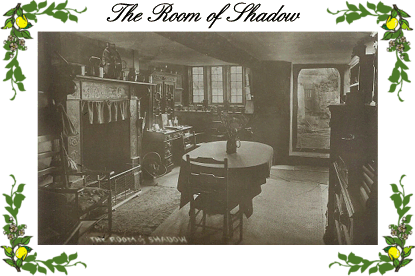
In contrast to the ‘room of shadow’ was a light airy room which Beatrice Chase called the ‘room of sunshine’ which acted as a combination of lounge and dining room.
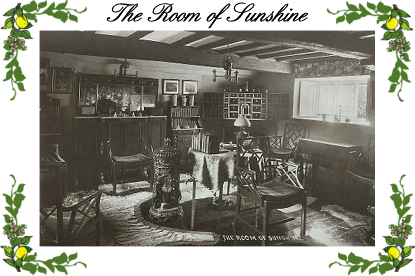
All her writing was done at a table in ‘angel corner’ where a small window gave both light and inspiration and became known as the ‘Dartmoor window’ which became the title of her second book – ‘Through a Dartmoor Window’.
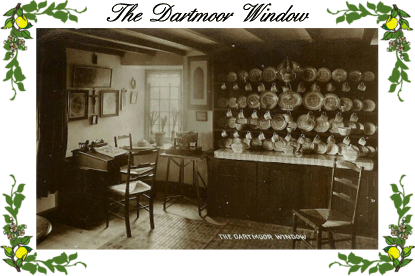
Beside the main house she built a small chapel that was always open to visitors with a lantern burning in the window. Inside the chapel the symbolic Rose of Lancaster denoting her royal lineage was evident in a stained glass window and on a silver chalice along with a silver lamp which was always kept near the altar. A roll of honour hung in the chapel along with many medals given her by the ‘White Crusaders’ along with a stained glass windows depicting a military cross. It was at this time that the grandson of the Duke of Buccleuch, and cousin to the Queen gave her what was to become her treasured possession. It was a cross set with single twelve stones comprising of jasper, sapphire, chalcedony, emerald, sardonyx, sardius, chrysalite, beryl, topaz, chrysoprase, jacinth and an amethyst. It was this last stone, the amethyst that became the name of her novel – The Twelfth, Amethyst.
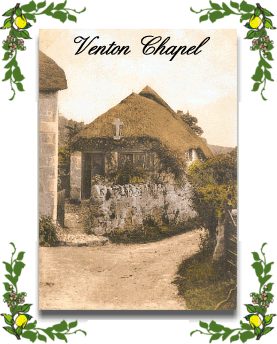
Not only did people, animals and rooms receive alternative names, some of the places on the moor did as well. Beatrice Chase often refers to Dream tor without actually saying where it is. The debate still goes on as to whereabouts she is alluding to, possibly with Wind tor (SX 70810 75821) being the one of the contenders however my money is on Top Tor? She often referred to the ‘Seven Sisters’ which was a group of seven fir trees on Yartor Down (SX 67221 74410). Beatrice Chase was also supposedly the woman who began the tradition of leaving fresh flowers on the suicide, Kitty Jay’s grave. She was also responsible for reviving the flagging Widecombe Fair in the 1930’s and restoring it to it modern-day popularity.
The Books.
Books and authors are always a personal thing and obviously over her career, Beatrice Chase received much acclaim for her portrayal of Dartmoor and its inhabitants. Probably the fairest thing to say is if that you want to know more try reading one of her works, most of the more popular ones can be bought for about £5. Personally I find them too flowery and Christian for my liking and I don’t mean that in a derogatory sense at all. The words are too enthusiastic and God must be praised for all the beauty on Dartmoor, well yes may be but not with so much gusto. Her main works are listed below:
The Heart of the Moor – 1914
Through a Dartmoor Window – 1915
Gorse Blossoms from Dartmoor (verse) – 1918
Pearl – 1919
Complete tales of my Knights and Ladies – 1919
Pages of Peace from Dartmoor – 1920
The Dartmoor Window Again – 1921
Lady Agatha, A Romance of Tintagel – 1922
Lady Avis Trewithen, A Romance of Dartmoor – 1922
A Dartmoor Garland (verse) – 1923
A Dartmoor Galahad – 1923
Devon and Heaven – 1924
The Voice of the River – 1925
The Cry for a Heart – 1925
A White-handed Saint – 1925?
Patricia Lancaster’s Revenge – 1928
The Twelfth, An Amethyst – 1929
Dartmoor Snapshots – 1931
The Passing of the Rainbow Maker – 1939
The Corpse on the Moor – 1946
The Dartmoor Window Forty Years After – 1948
Dartmoor The Beloved – 1951
White Knights on Dartmoor – 19??
A Red-handed Saint – 19??
plus various other works of poetry.
Reading List.
Chard, J. 1994 The Mysterious Lady of the Moor, Orchard Pub., Newton Abbot.
Green, C. 1975 My Lady of the Moor, Ideford Publications, Ideford.
 Legendary Dartmoor The many aspects past and present of Dartmoor
Legendary Dartmoor The many aspects past and present of Dartmoor

One comment
Pingback: An accidental visit to Venton Chapel | Dartmoor Hiking